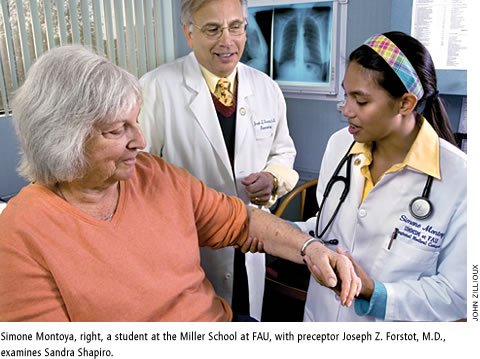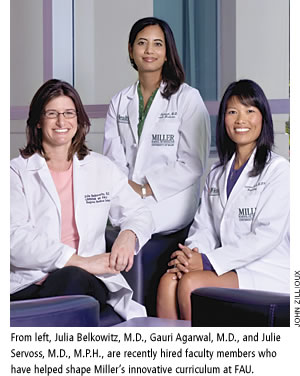|

In a well-appointed doctor’s office in Boca Raton, the exam room conversation between the 75-year-old patient and the woman taking her vitals is at once serious and cheerful. “Why do I get all these nutty illnesses?” the patient says before breaking out in a hearty laugh. She lists her ailments, including a possible infection in her toes. As she wiggles her toes, Simone Montoya shares in the laughter and for a moment it is as if a grandmother and granddaughter are catching up on old times.
Montoya, with her snow-white lab coat and cascading ponytail, moves like a seasoned physician as she checks the patient’s blood pressure and pulse. She asks a few questions, takes some notes, and gives just the right amount of assurance. Then they wait for the rheumatologist, Joseph Z. Forstot, M.D., the preceptor whose medical expertise Montoya has been soaking up since her first semester at the University of Miami Miller School of Medicine at Florida Atlantic University (FAU).
In a visit that lasted an hour, the patient was thoroughly examined by Forstot, with Montoya by her side every step of the way. “It’s amazing that we get to be so involved in patient care,” says Montoya, who is in her second year of the program based at FAU’s main campus in Boca Raton.
 Since the regional campus opened in 2004 as a public-private partnership between UM and FAU, it was charged with creating a curriculum that teaches the traditions of medicine along with a heavy dose of innovation and emphasis on chronic illnesses. Critical “real-world” hands-on training, including allowing students to help treat patients—starting in their first semester—is a hallmark of the program. Since the regional campus opened in 2004 as a public-private partnership between UM and FAU, it was charged with creating a curriculum that teaches the traditions of medicine along with a heavy dose of innovation and emphasis on chronic illnesses. Critical “real-world” hands-on training, including allowing students to help treat patients—starting in their first semester—is a hallmark of the program.
“I know the curriculum works because I see these students becoming doctors,” says Forstot, a 1975 Miller School grad and voluntary professor at the regional campus. “As Simone learns more clinical information at school and observes more here, she’s doing much more. This year she’s been doing procedures, like giving intramuscular injections, and we discuss different conditions and treatments. She is getting clinically savvy.”
Forstot is part of a large practice where other doctors also serve as preceptors to medical students such as Kevin Simonelic.
“The patients understand we are students, but they are willing to work with us under the guide of their doctors,” Simonelic says. “This is such a great opportunity because there is nothing like learning about an illness in class and then getting a chance to put a face to what you learn.”
In less than two years of medical school, Montoya, a future neurosurgeon, and Simonelic, who has a master’s degree in evolutionary biology and ecology, have racked up enough direct patient hours to rival students who have been in school longer in the more traditional medical education programs.
“When I went to medical school we really didn’t see patients until the third year; the first two years were primarily about basic sciences,” says Gauri Agarwal, M.D., assistant professor of clinical medicine who, along with Julia Belkowitz, M.D., and Julie Servoss, M.D., M.P.H., all recently hired faculty members, was charged with creating the new Physicianship Skills and Integrated Patient Care courses.
Physicianship Skills covers big, important themes in physician training such as ethics, cultural competency, geriatrics, and evidence-based medicine. Integrated Patient Care includes both weekly rotations with a practicing community physician and Palm Beach County Department of Health visits with full-time clinical faculty.
“Here, students are seeing patients in the afternoons at least twice a week in clinics with their preceptors and at panel discussions, where we bring in people who suffer from various illnesses to talk about their lives,” says Belkowitz, assistant professor of clinical pediatrics. “Students are able to make that link between what they learn in the morning and what they do in the afternoon when they get a chance to help with patients.”
In many cases, students at the Miller School at FAU will be able to follow the same patients during all four years of medical school, an experience difficult to duplicate in most academic settings—especially when considering students’ exposure to a broad spectrum of patients, including people of various ethnic, economic, and cultural backgrounds.
The curriculum, of course, is still in line with what is taught on the main Miller campus in Miami, but the regional outpost’s smaller enrollment enables different methods of imparting medical education.
“We have given our utmost attention to creating a curriculum that will prepare our students to become highly skilled professionals who communicate well, are culturally and ethically competent, and are masterful at working well with fellow physicians and all other health care professionals,” says Daniel Lichtstein, M.D., senior associate regional dean for medical education and professor of medicine.
The Miller School at FAU curriculum has already been recognized with a Josiah Macy Foundation grant, awarded through the Association of American Medical Colleges, for its focus on chronic disease management and continuity of care.
“Our students still get the core concepts of medicine—basic sciences, organ systems modules, the basic science side of being a physician,” says Servoss, assistant professor of clinical medicine.
“But at the same time we acknowledge that there are other critical elements of patient care. We feel it’s our responsibility to expose our students to the social sciences, including topics such as medical economics, medical error, social determinants of health, and cultural competency.”
Though Servoss, Agarwal, and Belkowitz are experienced doctors, they are not that long out of medical school, and the memories of their years at Harvard, UM, and Jefferson, respectively, are still fresh. They recall their own joy when they were able to help treat patients and then discuss illnesses and treatments with faculty and colleagues.
This curriculum places a major emphasis on small-group, problem-based learning. Students get to dissect clinical problems and come up with solutions, drawing heavily on knowledge from science lectures.
“From the very first problem-based learning case we’re asking them to think and approach their learning in a different way,” Servoss says. “They have to consider the limitations in their knowledge base, independently find the answers to their questions, and ultimately understand what is happening to the patient in the case, why it’s happening, and what to do about it. We mimic what they will be doing every day as physicians treating patients.”
The hands-on elements of the curriculum, coupled with the small classes and emphasis on small-group learning, interested Montoya when she was looking for a medical school. Her qualifications—outstanding undergrad at Smith College and a fellowship in the Department of Neurology at Yale—made the Gainesville native a competitive prospect.
“Going to a liberal arts college, I was accustomed to working in small groups,” says Montoya. “I feel that in medicine the doctor is a concerned clinician and a problem-solver, and that’s the focus here.”
According to Stephanie Wragg, Ph.D., assistant dean for medical curriculum and director of faculty development at the Miller School at FAU, many medical schools are pushing early clinical exposure “because there is a feeling that waiting for the clerkship year was just a little late.”
“But we really push the envelope here in that—by week three of year one, our students are already in a community physician’s office one afternoon a week and in a Department of Health clinic,” says Wragg.
“At medical school interviews students are so excited: ‘I want to be a doctor. I want to help people!’ Then they sit in the classroom for four to five hours a day, every day, and that reduces their enthusiasm. We are changing that,” explains Wragg.
The curriculum also was a big attraction for Marvin Smith, a former college football player who has a master’s in biomedical sciences from FAU.
“We are learning a lot about the art of medicine; how to make bold decisions that are best for the patient, decisions that are really going to impact the patient’s well-being, way beyond writing a prescription,” notes Smith.
Smith’s class of 32 students, the first that will spend all four years at FAU, is also the first that will study under the updated curriculum throughout medical school. Prior classes spent two years in Boca Raton followed by two more years at the Miami campus. Last fall, the entering class grew to 48 students, including Danielle Cameron. Hailing from Baltimore, she studied philosophy and Spanish at Haverford College then went on to a two-year post-baccalaureate premed program at Harvard.
“I was interested only in schools that had a very early clinical component in their curriculum, but this was the only school that I found to have such a great emphasis and holistic approach, not in terms of holistic medicine, but a whole-person approach.”
Only a day earlier, Cameron was one of four Miller School at FAU students who spent several hours at a Palm Beach County Department of Health clinic, observing pediatric cases. Under the watchful eyes of a UM faculty member she was allowed to take a patient’s history.
“That’s something some of my friends at other medical schools are doing just in their third year,” Cameron says. “We are learning and getting a chance to use our knowledge as we go along.”
The regional campus curriculum also offers multiple opportunities for health care advocacy. Each student is paired with a community-based organization where they learn the basics of health care advocacy and see a diverse group of patients. Current projects include sun safety, domestic abuse, and food scarcity.
As the course designers work with other faculty on offerings for the third and fourth years, they are considering ways to ensure medical education adequately responds to national and global trends in health care, especially with growing concerns about chronic illness.
“Through the curriculum, we are trying to always be relevant and provide students with the skills to practice medicine in a very competent and caring fashion,” says Agarwal. “We have the luxury of providing a curriculum that draws from methods that have worked very well in other medical schools around the country—problem-based learning, early and integrated clinical exposure, and humanism in medicine. We have brought these areas together and made them the foundation for our doctors of tomorrow.”
|


